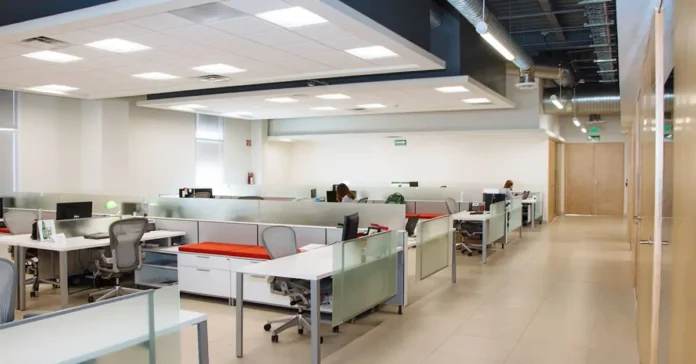In today’s fast-changing work environment, making the most of office spaces is really important. That’s where the idea of workspace optimization comes in handy. One big part of this is when companies decide to downsize their offices. This means they’re looking to make things more efficient and save money without making the work suffer. They often choose to downsize to be more flexible and efficient. But, doing this without thinking about how the workspace should be can cause problems.
That’s why it’s important for companies to think about these six factors when they downsize. By doing that, they can make sure their workspace stays set up for success. This means creating a space where people can work well together, stay healthy, and help the company grow. In this article, we’re going to talk about workspace optimization, with a special focus on six important things to think about when a company decides to downsize.
Understanding Workspace Optimization
Downsizing happens when a company needs to be smaller for different reasons. It can be to save money or to be more flexible. But, when a company gets smaller, there are challenges. These can include people feeling unsure about their jobs or the work environment changing a lot. That’s where strategic workspace optimization comes in. It means being smart about how to make the smaller space work well. By planning things carefully, a company can make sure that even when they’re smaller, the workspace is still set up for success. So, it’s like rearranging things in the house – making sure everything fits just right.
Factor 1 – Space Utilization for Workspace Optimization
In the first factor, we look at how your office space is being used. It’s like taking a good look around to see what’s happening. We want to find places where we can bring things closer together and use the space better. This helps us make things more efficient.
First, we check how things are right now. Are some areas too crowded, or maybe some spaces are not used much? Then, we figure out where we can bring things closer or make changes to use the space smarter. It’s like solving a puzzle to make everything fit just right.
Finally, we put smart strategies in place to make sure each part of the space is used in the best way. This helps people work better and makes the whole office feel more organized and comfortable. So, by thinking about how we use our space, we can make our office a great place for everyone!
Factor 2 – Ergonomic Design Considerations
In making your office a comfy and efficient place, think about how it’s set up. That’s where ergonomic design comes in, which is just a fancy way of saying making things work well for people. Imagine desks and chairs that fit just right, helping everyone feel good while they work.
Why does it matter? Well, when the furniture and setup are just right, it makes a big difference. People feel less tired, work better, and stay healthier. So, when downsizing your office, don’t forget about the importance of picking the right furniture and arranging everything in a way that’s good for everyone. It’s like creating a happy and productive space where everyone can do their best work. Remember, happy employees mean a successful and thriving workplace!
Factor 3 – Technological Integration for Workspace Optimization
In the tech-savvy world of work, using technology smartly is a big factor in making things run smoothly, especially when downsizing. Think of it like upgrading your tools to make your job easier. By bringing in technology, like digital solutions and easy-to-use gadgets, you’re making the workspace work better. Imagine everyone being able to connect easily, share information faster, and get things done without a hitch.
During downsizing, it’s crucial to keep everyone connected and operations flowing seamlessly. So, embracing technology is like giving your workspace a helpful upgrade, making it not just efficient but also a cool and connected place to work. With the right tech tools, downsizing becomes a smoother ride, ensuring everyone stays in the loop and the workflow stays on point.
Factor 4 – Collaboration and Communication
In a smaller office, it’s super important for everyone to work together smoothly. So, we focus on making teamwork strong and keeping everyone connected. We encourage everyone to share ideas and help each other out. Using tools like instant messaging and regular team meetings helps everyone stay on the same page. We also make sure that even though we’re a smaller team now, we still feel like one big family.
By fostering collaboration, using good communication tools, and making sure everyone feels connected, we create a friendly and efficient workspace. In our downsized setup, it’s not just about getting the work done; it’s about doing it together and making the most of our smaller, close-knit team.
Factor 5 – Employee Well-being
In times of downsizing, taking care of employees’ well-being becomes super important. First off, it’s important to listen to their worries and answer any questions they might have. Creating a supportive environment is like building a comfy nest for everyone. It means making sure the office feels positive and safe, both mentally and physically.
Keep the team spirit alive by communicating openly and often. Let them know their efforts matter, and acknowledge achievements, no matter how small. Strategies for maintaining morale and motivation can include team-building activities, celebrating successes, or even just having regular check-ins to see how everyone is doing. By prioritizing the well-being of your employees during downsizing, you’re not just making the workplace better; you’re creating a supportive family where everyone feels heard, cared for, and ready to tackle any challenges together.
Factor 6 – Flexible Work Arrangements
When we talk about flexible work arrangements during downsizing, we mean giving employees options that make work easier for them. This can be having different work hours, letting people work from home, or adjusting to new ways of working.
- Implementing flexible work schedules and remote options- Making work hours more flexible and allowing employees to work from home can be like giving them superpowers. It helps them balance work and life in a way that suits them best. This might mean working at different times or even working from a cozy spot at home.
- Adapting to changing work patterns – Work patterns change, and that’s normal. Companies need to be like superheroes too, ready to adapt to these changes. Maybe more people prefer working from home, or they like starting work a bit later. Being open to these changes makes everyone’s work-life better.
- Ensuring adaptability in the downsized workspace – Even when the workspace gets a bit smaller, it’s important that it’s like a superhero too – adaptable. This means being ready for changes in how people work, making sure everyone can do their best work, no matter where they are. Flexibility and adaptability make the downsized workspace a dynamic and comfortable place for everyone.
Final Words
In wrapping up our exploration of optimizing workspaces during office downsizing, let’s recap the main points. Firstly, assessing how space is used, making it ergonomic, and integrating technology are crucial. Secondly, fostering collaboration, supporting employee well-being, and embracing flexible work arrangements are key factors. It’s like putting together pieces of a puzzle – each factor contributes to creating a workspace that’s not just efficient but also considerate of the people working in it.
Remember, a smart and strategic approach is the way to go. Think of it as planning a route for a road trip – you need to know where you’re going, consider the best paths, and ensure everyone’s comfortable along the journey.
Most importantly, as businesses navigate the downsizing process, the well-being of the team should remain a top priority. Happy and comfortable employees lead to a more productive and successful workspace.
So, to all the businesses out there, big or small, remember: optimizing your workspace during downsizing isn’t just about saving space and costs. It’s about creating a space where everyone can work happily, efficiently, and feel supported. Cheers to a workspace that truly works for everyone!
FAQs
A1: Evaluate team dynamics, technological needs, and flexible work arrangements to ensure a streamlined and efficient downsizing process.
A2: Reconfigure office layouts to prioritize collaborative spaces, open communication, and multifunctional areas, maximizing efficiency and flexibility.
A3: It brings remote work solutions, virtual collaboration tools, and streamlined communication channels for a more agile and efficient workspace.
A4: Prioritize employee well-being by providing support services, maintaining transparent communication, and fostering a positive work culture to ease the impact of downsizing.
A5: Implement smart storage solutions, digitize documents, and embrace minimalist design principles to reduce physical clutter.
A6: Downsizing can impact morale; however, proactive communication, transparency, and employee engagement initiatives can help mitigate negative effects
A7: Prioritize ergonomic furniture, multifunctional equipment, and sustainable solutions to optimize the downsized workspace.
A8: Implement flexible work options such as hot-desking, remote work policies, and staggered schedules to optimize workspace usages.
A9: Involving staff in decision-making, seeking input on workspace design, and addressing concerns helps create a downsizing process that considers diverse perspectives.
A10: Foster a sense of community by organizing regular team-building activities, encouraging open communication, and creating spaces within the downsized office to maintain a positive work environment.







